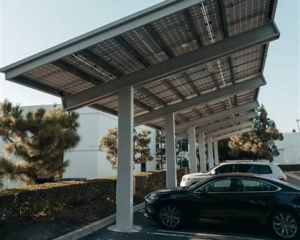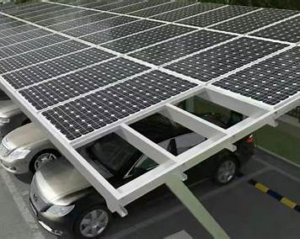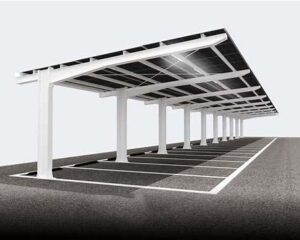What Is a Solar Carport?
A solar carport is a covered structure built over parking spaces that has solar panels mounted on top. Unlike traditional rooftop solar systems, solar carports make use of unused parking areas and provide shade for vehicles while generating clean electricity.
Average Solar Carport Cost in 2025
The cost of a solar carport depends on its size, design, materials, and location. Below is an overview of the typical price ranges:
| System Size | Power Capacity | Estimated Cost (USD) | Average Cost per Watt |
| Small Residential | 2–10 kW | $8,000 – $30,000 | $3.00 – $4.00 |
| Medium Commercial | 10–100 kW | $30,000 – $250,000 | $2.50 – $3.50 |
| Large-Scale Projects | 100 kW+ | $250,000+ | $1.80 – $3.00 |
Tip: Solar carports typically cost 10–20% more than rooftop solar because of extra steel structure and foundation work. However, they offer dual-use of space and vehicle protection, which can offset the higher upfront cost.
A solar carport’s core components
1. Structural Support System: Main frame (aluminum/steel), columns, beams/purlins, and foundation (concrete footings/anchors) – the load-bearing “skeleton” ensuring stability.
2. Solar Power Generation System: Solar PV panels, mounting brackets, and inverter (converts DC to AC) – the energy-producing core.
3. Electrical Control & Protection System: Wiring/cables, distribution box, monitoring system, grounding/lightning protection, and safety devices (breakers/fuses) – ensures safe, efficient power transmission.
4. Auxiliary Functional System: Drainage (gutters/downspouts), optional EV chargers, and lighting – enhances shelter usability and practicality.
Can solar carports withstand storms?
Yes, well-designed and properly installed solar carports can indeed withstand storms, including strong winds and heavy snow.
Solar carports can withstand storms mainly due to these core factors :
1. Engineered to local building codes, accounting for wind, snow, and rain loads;
2. High-strength, corrosion-resistant materials (steel/aluminum frames) and rigid structures;
3. Secure foundations (deep concrete footings/anchors) and heavy-duty fasteners to resist uplift/wind;
4. PV panels and mounting systems certified for wind/hail resistance;
5. Sloped roofs for water/snow runoff, preventing structural stress.
In essence, they are not simple shelters but engineered structures built to meet strict safety and building standards.
Factors That Affect Solar Carport Cost
Several variables can influence the final price of your solar carport:
- System size and power output – Larger systems benefit from economies of scale.
- Type of structure – Single-slope, dual-slope, or custom design affects steel quantity.
- Material choice – Galvanized steel vs. aluminum frames.
- Local labor and permitting costs – These vary widely by region.
- Electrical infrastructure upgrades – Transformer or grid connection costs.
- Optional features – EV chargers, battery storage, LED lighting, snow/wind resistance upgrades.
Solar Carport ROI and Incentives
While the upfront solar carport cost can be high, incentives can make the investment worthwhile:
- Federal Tax Credit: Up to 30% under the ’s Investment Tax Credit (ITC).
- State/Local Rebates: Many states offer cash rebates or property tax exemptions.
- Accelerated Depreciation: Businesses can recover part of the investment quickly.
- Energy Savings: Generate electricity to reduce utility bills for decades.
Average payback period: 5–9 years for commercial systems, 7–12 years for residential systems.
Pros and Cons of Solar Carports
Advantages
- Maximize unused parking space
- Generate renewable electricity
- Provide shade and weather protection
- Increase property value
- Ideal for both homes and businesses
Disadvantages
- Higher upfront cost than rooftop systems
- Requires open space for installation
- Longer permitting and engineering time
How to Reduce Solar Carport Costs
- Get quotes from multiple experienced solar installers
- Install during off-peak construction seasons
- Apply for all available tax credits and rebates
- Choose standardized designs to reduce custom engineering fees
- Bundle EV charging stations for additional incentives
FAQ: Solar Carport Cost
Q1: How much does a residential solar carport cost?
A: Typically between $8,000 and $30,000, depending on size and materials.
Q2: Are solar carports worth the cost?
A: Yes, they provide long-term energy savings, vehicle protection, and property value increases.
Q3: Can I finance a solar carport?
A: Yes, through solar loans, leases, or power purchase agreements (PPAs) for businesses.
Q4: Do solar carports require maintenance?
A: Very little—just periodic panel cleaning and structural inspections.
Q5: How long does it take to install a solar carport?
A: The total timeline typically ranges from 2 to 6 weeks (residential: 2–3 weeks; commercial: 4–6 weeks). This includes:
Planning & Permitting (1–4+ weeks): For design, engineering, and securing municipal permits (timeline highly dependent on local authority efficiency).
OnSite Construction (1–3 weeks): Foundation work, frame assembly, and panel mounting.
Electrical Integration (~1 week): Wiring, inverter installation, and final grid connection.
Note: Larger or more complex commercial projects can take 8+ weeks. Weather delays and material availability can also impact the schedule.
Q6: Are there space or terrain restrictions for installing a solar carport?
A: Yes—key site requirements include:
Minimum Clear Space: Residential: ~20 ft x 10 ft per 2car unit; Commercial: ~18 ft x 9 ft per parking space.
Suitable Terrain: Flat or gently sloped land is ideal. Steep slopes require more complex (and costly) foundations and engineering. A geotechnical survey may be needed for large commercial sites.
Sunlight Exposure: No major shading from trees or buildings. The site should receive 6+ hours of direct sunlight daily for optimal generation.
Grid Access: Proximity to existing electrical panels reduces wiring complexity and cost.
Q7: What’s the warranty for a solar carport?
A: Warranties vary by installer and manufacturer, but standard offerings include:
Structural Frame: 10–25 years for galvanized steel or aluminum.
Solar Panels: 25year performance warranty (guaranteeing ~80% output) and a 10–15year product warranty.
Inverter: 10–15 years.
Installation & Labor: 1–5 years of workmanship warranty, covering issues like leaks or wiring faults.
*Always read the warranty terms carefully to understand what is and isn’t covered.*
Q8: How efficient are solar carports in winter or rainy seasons?
A: They continue to generate power but at reduced efficiency:
Winter: Output can be 30–50% lower due to shorter days, snow cover, and a lower sun angle. Sloped designs help shed snow, and panels can still produce power from diffused light.
Rainy/Cloudy Days: Output may be 20–40% lower. While direct sunlight is optimal, panels can still generate electricity from diffused sunlight through the clouds.
Actual efficiency loss depends on your geographic location and local climate. Pairing your system with a battery helps mitigate this by storing excess power from sunny days.
Q9: Can I relocate or disassemble a solar carport if I move?
A: While physically possible, it is generally not costeffective for residential systems.
The cost of disassembly, transportation, and reinstallation can be a significant fraction of the original price, often making it uneconomical.
Commercial systems with modular designs are easier to relocate but still require new engineering assessments and permits for the new site.
In most cases, it is better to include the carport in the sale of the property, as it is a recognized valueadded feature.
Follow us : Facebook










